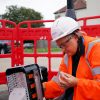Ofcom UK Detail 5G Mobile Auction Plan for 26GHz and 40GHz

The UK telecoms regulator, Ofcom, has today set out the design of their planned auction for a large chunk of millimetre wave (mmW) radio spectrum frequency across the 26GHz and 40GHz bands, which is to be used by mobile network operators to deliver even faster 5G (mobile broadband) services – mostly across urban areas.
At present EE (BT), O2 (VMO2), Vodafone and Three UK already have access to several 5G friendly mobile bands between 700MHz to 3.8GHz. Such frequency reflects the same sort of mid-band radio spectrum that mobile operators have been harnessing since the advent of the first 3G and 4G data networks some years ago.
The move to auction off the two higher frequencies of 26GHz and 40GHz is designed to complement that by providing mobile providers with lots of additional spectrum frequency, which means more data capacity to potentially support extremely fast speeds (e.g. multi-Gigabit performance is easier).
Advertisement
The catch is that such signals are easily disrupted (very weak) and can only travel a short distance in a mobile environment, which means that mmW bands are more useful when serving densely populated areas (e.g. city shopping malls, airports, events etc.) or for fixed wireless access (FWA) style broadband links to specific homes and businesses.
Ofcom also already revealed that they plan to award 15-year, fixed term citywide licences (“high density areas”) to use the “new” mmWave bands in 68 major towns and cities across the UK. The regulator will also assign more localised licences (“low density areas”) within these cities – and elsewhere in the UK, where they expect deployments to be sparser – on a first come, first served basis, using their Shared Access licensing framework. Today they’ve followed this up with more details on the auction design itself.
What Ofcom Have Decided
The geographic scope of licences to be awarded in the auction will be subnational, with each licence authorising the licensee to use the relevant spectrum in all the major cities and towns (“high density areas”) in which we expect the highest volume of deployment of mmWave spectrum.
There will be three categories of spectrum lots:
• 26 GHz lower (25.1-26.5 GHz) – 7 x 200 MHz lots;
• 26 GHz upper (26.5-27.5 GHz) – 5 x 200 MHz lots; and
• 40 GHz (40.5-43.5 GHz) – 15 x 200 MHz lots.Each spectrum lot will comprise a block of 200MHz.
Reserve prices will be £2m for each lot of 26 GHz lower and 26 GHz upper, and £1m for each lot of 40 GHz.
Bidding for frequency-generic lots, in the auction’s principal stage, will decide the quantity of spectrum each bidder will be allocated in each lot category. The format of the principal stage will be a clock auction.
The assignment stage will follow the principal stage and will decide the precise frequencies of the quantities of spectrum allocated to each winner in the principal stage.
In the last auction, Ofcom also included a negotiation period as part of the final assignment stage, which gave winners of the spectrum an opportunity to agree that their respective allocations of spectrum will be adjacent (i.e. beneficial for reasons of network performance and cost). However, the regulator has “provisionally” decided not to do so this time, although they remain open to the possibility.
“The cost savings that adjacency of spectrum holdings will make possible after the 26 GHz clearance deadline in the 26 GHz band, and in the 40 GHz band once equipment for that band is available, are unknown. It is also unknowable whether operators will ultimately share radio equipment (whether or not their spectrum holdings are adjacent), or, instead, prefer to deploy independently, in order to maximise flexibility to deploy, innovate or to differentiate services. In addition, as noted in Annex 8, it may be possible for operators to deploy shared networks even without adjacent spectrum holdings,” said Ofcom.
Advertisement
Historically, the years leading up to a new mobile spectrum auction have been ugly affairs, which tend to involve a lot of squabbling between mobile operators, legal challenges and significant delays. But the mmW bands are new territory, with many mobile operators and likely to find their application are more challenging, which may arguably make them less competitively contentious.
On top of that and in an effort to avoid any complications, Ofcom won’t be holding the auction until AFTER the competition watchdog (CMA) has decided the outcome of Vodafone and Three UK’s proposed merger (here) – this is sensible as that may involve some changes in competitive spectrum ownership. Put another way, mobile operators don’t yet know if they’ll have anything worth squabbling over, at least not until the detail of that merger are known – this may include the divestment of some spectrum to rivals.
The CMA’s final decision on the proposed merger between Three UK and Vodafone isn’t expected until September 2024, while Ofcom will be consulting upon their proposed auction design (here) until 9th January 2024. In other words, the auction itself seems unlikely to get underway until sometime in 2025 and that’s assuming there are no problems or squabbles along the way (a dangerous assumption, given the history of these things).
Mark is a professional technology writer, IT consultant and computer engineer from Dorset (England), he also founded ISPreview in 1999 and enjoys analysing the latest telecoms and broadband developments. Find me on X (Twitter), Mastodon, Facebook, BlueSky, Threads.net and Linkedin.
« London Full Fibre ISP G.Network Grows EV Fleet with 100 Vans























































All I can see with this is EE buying most of it and the other network not having much left to buy.
These two new 5G frequencies must not be implemented until all of UK has the current 5G signal. Should this new facility be installed whilst us out in the sticks are still struggling with 4G. Paying an increasing monthly sum while they, 4 networks, offer a 5G service for free
Then move to a town. Stop expecting others to subsidise your lifestyle.
The one place most people generally don’t need good 5G is at home….
People who live in towns and cities frequently go to the countryside, and people who live in the countryside frequently go to towns and cities.
Of course the fundamental difference is that the countryside is a bigger area with lower population density, meaning spreading bandwidth over a vast geographical area, whereas towns and cities require a vast amount of bandwidth in a tiny area.
Putting a new mast up in the countryside is also riddled with pain – apart from the fact that it costs far more to get power and bandwidth to where you need it, you have to spend eternities arguing with NIMBYs who complain about having no signal whilst simultaneously making it almost impossible for communications providers to install new masts. By comparison, the only really significant expense of deploying in a city is congestion charges, the odd parking ticket and whatever it costs to close the road for a day or two. Maybe once in a while you might have to dig up the road to unblock a duct.
I’m being obviously flippant, but it’s just such an obvious thing that of course infrastructure is going to be deployed to where it’s cheapest and going to benefit the most users most easily first…
5G will get the countryside one day – if the people who live there ever stop putting the networks off and let them build the masts!
define “struggling”, what can you not do on 4G?
I went to the parents place a little while back and noticed I can get 5G there now. Makes no difference – the VDSL is more than adequate for internet access and the upcoming FTTP will be even better.
Stop living in the middle of nowhere. You only get the benefits of being urban if you live in an urban area, silly sausage.
I doubt these frequencies will be deployed to rural communities, read this bit.
The catch is that such signals are easily disrupted (very weak) and can only travel a short distance in a mobile environment, which means that mmW bands are more useful when serving densely populated areas (e.g. city shopping malls, airports, events etc.) or for fixed wireless access (FWA) style broadband links to specific homes and businesses.
As for those gabbling on about move to towns etc, where do you think you food comes from? There are hardworking farmers that live in the ‘sticks’ who need reliable decent communication to carry out allsorts of activities.
I live in a very rural location and Three provide 5G to my village, we can only get 25mbps FTTC home broadband but after switching to Three’s 5G hub we now get speeds around 400mbps. They actually have quite a lot of rural 5G in Norfolk, they don’t seem to want to put it on their coverage maps though, it’s been rolling out for years and still hasn’t made it to their coverage map. They even have a 5G cell site in the middle of the forest for some reason.
I’m wearing my 5G demonic-deepstate-and-alien-wave-proof tinfoil hat as I type.